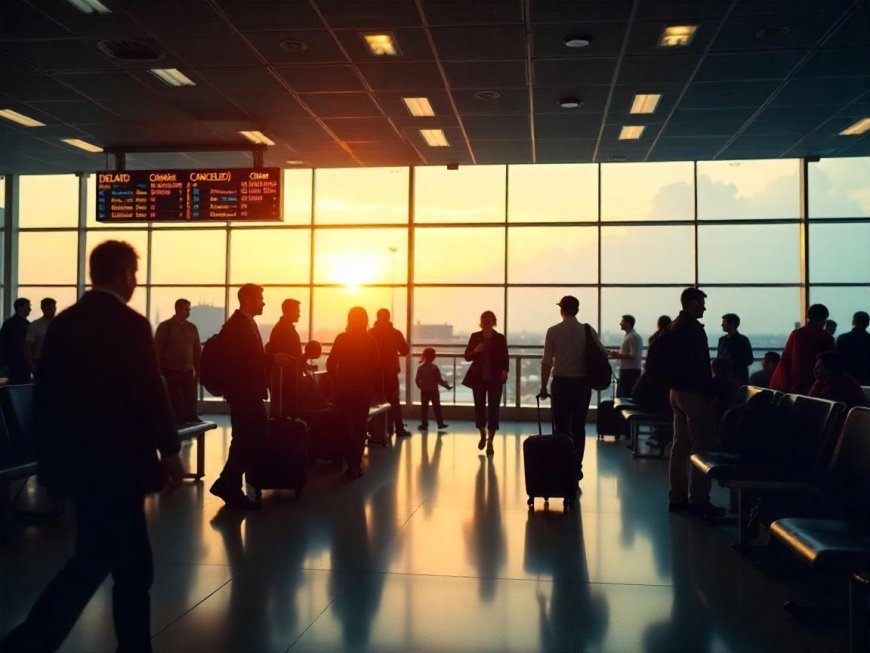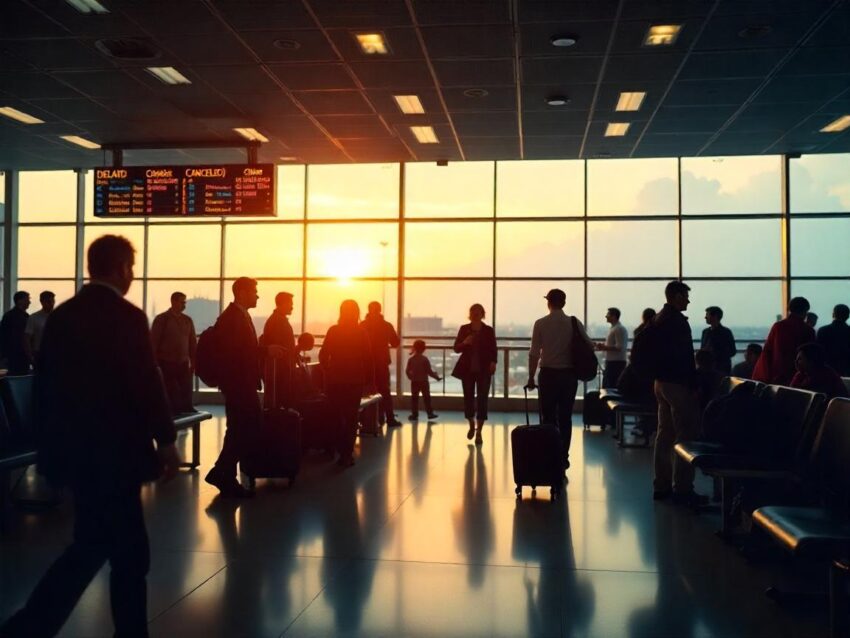More Than Twenty-Six Thousand Five Hundred Flights Disrupted and Eight Hundred Seventy-Six Axed, Now US Air Routes Bear the Brunt of Summer Travel Chaos, Here is the Latest Update


More than twenty-six thousand five hundred flights stand disrupted, and eight hundred seventy-six have been axed, sending shockwaves through the global travel network. Now, United States air routes bear the brunt of a summer travel chaos that refuses to loosen its grip. Airports that should be buzzing with vacation joy and business momentum have become scenes of mounting frustration and tense uncertainty.
From terminals echoing with urgent announcements to travelers glued to their phones, desperate for updates, the skies have turned into a battleground of delays, cancellations, and logistical nightmares. Outside, dark clouds and relentless storms fuel the havoc, while inside, passengers and airline staff grapple with long lines, changing gates, and elusive answers. As the chaos deepens, the United States finds itself at the epicenter of this unfolding crisis. Here is the latest update on how this travel storm is reshaping journeys and testing patience everywhere.
This summer, American skies have become a battlefield. Instead of smooth journeys and sun-drenched vacations, travelers face a relentless storm of flight delays and cancellations that’s leaving chaos in its wake. From Chicago O’Hare to Reagan National, from LaGuardia to Denver, America’s airports are caught in a crisis that is reshaping the summer travel season.
On July 16, 2025, the situation reached new heights of disruption. Over 26,500 flights were delayed globally, with nearly 6,000 delays affecting flights within, into, or out of the United States. A staggering 876 flights were canceled around the world, and more than 500 of those were tied to U.S. routes. The statistics tell one story, but the human experience tells another—a story of missed connections, exhausted travelers, and an aviation industry under tremendous pressure.
Storms Trigger an Aviation Catastrophe
Summer storms are nothing new for the aviation industry, but the ferocity of the system that hit the U.S. in mid-July was exceptional. A vast storm front swept through the Midwest and surged eastward, bringing fierce winds, pounding rain, and relentless lightning strikes.
At Chicago O’Hare International Airport, the storm created a logistical nightmare. Ground crews battled rain and lightning, forcing repeated ground stops. Pilots were left waiting for takeoff clearance while passengers stared out rain-streaked windows in frustration. On July 16 alone, O’Hare logged 55 cancellations and a jaw-dropping 458 delays, affecting 34% of all its scheduled flights that day.
The storm didn’t just stall flights—it ripped through the intricate web of connections that ties America’s air system together. Flights from O’Hare feed hundreds of other destinations. When O’Hare stumbles, the entire network reels.
New York’s Trio in Turmoil
As the storm system rolled east, it collided with some of the busiest air corridors in the world. New York City’s major airports—LaGuardia, JFK, and Newark—were plunged into pandemonium.
LaGuardia, already infamous for congestion, saw 30 cancellations and 115 delays on July 16, disrupting 20% of its operations. JFK endured 22 cancellations and 123 delays, while Newark reported 19 cancellations and an eye-opening 209 delays, representing a 20% delay rate for the day.
Travelers at these airports described scenes of frustration and fatigue. Lines at customer service counters stretched for hundreds of feet. Airport lounges, often a refuge for frequent flyers, were standing-room-only as passengers scrambled for updates or alternative flights.
Reagan National and BWI Feel the Pain
The nation’s capital was not immune. Reagan National Airport recorded 46 cancellations and 105 delays on July 16, meaning nearly 23% of flights were impacted. The usually efficient airport became a picture of stress as thunderstorms forced repeated air traffic halts.
Nearby Baltimore/Washington International (BWI) experienced 35 cancellations and 56 delays, with 15% of its flights disrupted. Travelers there faced similar stories of dashed hopes and shifting departure boards.
Boston and Philadelphia Under Siege
Further north, Boston Logan International Airport felt the sting of the summer storm season. On July 16, Logan reported 14 cancellations and 116 delays, with nearly 15% of flights impacted. From business travelers to families headed to Cape Cod, the ripple effect was immediate. People missed meetings, vacations were postponed, and rebooking windows grew narrower by the hour.
Philadelphia International Airport also suffered. It saw 13 cancellations and 96 delays, leaving travelers trapped in terminals amid mounting frustration.
Denver’s Skies Turn Dark
While much of the chaos was centered on the East Coast, Denver International Airport experienced its own meteorological onslaught. Thunderstorms and sudden downpours rolled across the Rockies, snarling operations at one of the nation’s most important hubs. On July 16, Denver logged 11 cancellations and 278 delays, with a staggering 43% of flights running behind schedule.
Denver’s problems didn’t stay local. As a major connecting hub, delays there spilled into schedules for flights stretching coast-to-coast.
Airlines Grapple With the Storm’s Fallout
No airline escaped the wrath of this weather system. The numbers were grim across the board, underscoring just how interconnected—and vulnerable—modern aviation has become.
Republic Airways
Republic, a significant regional operator for larger carriers, endured 117 cancellations and 217 delays, translating to a 16% delay rate. As a backbone of domestic connectivity, Republic’s troubles rippled into the schedules of major airlines like American and United.
Southwest Airlines
Southwest, the giant of U.S. domestic travel, felt the weight of the storm. On July 16, it recorded 92 cancellations and a staggering 1,016 delays—affecting 24% of its operations. The airline issued waivers, allowing free flight changes, but that was little comfort for travelers stuck in cities far from home.
SkyWest Airlines
SkyWest, another regional stalwart, posted 48 cancellations and 400 delays, with 15% of flights impacted. As with Republic, its troubles were amplified because SkyWest operates under various brand names for major airlines.
American Airlines
American Airlines faced an overwhelming challenge. It recorded 42 cancellations and an eye-popping 957 delays—impacting more than a quarter of its flights. From major hubs like O’Hare to LaGuardia and Dallas/Fort Worth, American’s schedule teetered on collapse as aircraft and crews found themselves scattered across the country.
Endeavor Air and PSA Airlines
These Delta Connection and American Eagle affiliates suffered significant blows, each logging 42 cancellations and over 100 delays. For passengers booked on regional jets, it often meant the first flights cut when storms hit.
Envoy Air
Envoy, another vital regional player for American, faced 41 cancellations and 205 delays, amounting to an 18% delay rate. Regional airlines often operate on tight schedules with fewer spare aircraft, making recovery from disruptions especially challenging.
China Eastern
Though a global powerhouse, China Eastern saw modest impact in the U.S., with 20 cancellations and 847 delays, reflecting 32% of its flights. Many of these delays were due to disrupted connections at major U.S. gateways like JFK and LAX.
United Airlines
United recorded 19 cancellations and 731 delays, with a 24% delay rate. As a major player at Newark, O’Hare, and Denver, United was deeply affected by the domino effect of weather chaos.
Batik Air
Batik Air, operating long-haul routes to the U.S., logged 17 cancellations and an incredible 161 delays, representing a massive 52% delay rate on July 16. For travelers flying halfway across the globe, delays were particularly costly.
Delta Air Lines
Delta, too, felt the heat of the storm. It posted 14 cancellations and 589 delays, with 16% of flights impacted. From Atlanta to Boston to New York, Delta’s network shuddered under the strain.
Other Airlines
Spring Airlines, Qantas, Air Canada, Jazz, and others all saw moderate disruptions, though with fewer total flights in the U.S., their impact was smaller in scale.
The Anatomy of an Aviation Meltdown
This meltdown didn’t happen overnight. America’s aviation system is a delicate machine, dependent on weather, staff availability, aircraft rotations, and passenger demand. A storm in Chicago quickly translates to missed connections in New York. Ground stops in Denver echo into delays in Boston. It’s a cascading chain reaction.
One contributing factor is the ongoing air traffic controller shortage. Staffing levels remain below pre-pandemic strength. Fewer controllers mean less flexibility to handle sudden surges or weather diversions. When the skies are already crowded, a single ground stop can trigger hours of delay.
Another factor is the airlines’ aggressive summer schedules. Carriers have packed more flights into fewer time slots to maximize revenue. While efficient, this leaves little margin for error. When storms strike, there’s no slack in the system to recover quickly.
The Human Side of Aviation Chaos
Behind every delay statistic is a human story. Families stranded overnight in terminals. Business travelers forced to cancel important meetings. Honeymooners stuck thousands of miles from paradise.
Social media became a digital confessional as frustrated passengers shared tales of endless waits, conflicting information, and mounting costs. Some travelers posted photos of gate areas turned into makeshift dormitories. Others described hours on hold with airline customer service, desperate for rebooking.
Airline employees, too, bore the brunt. Gate agents faced shouting passengers. Pilots and flight attendants struggled to find hotel rooms after duty-time restrictions stranded them mid-trip. For many, it was one of the most stressful weeks of their careers.
Airlines Fight to Recover Trust
In response, airlines rolled out travel waivers, allowing passengers to change flights without fees. But with planes already full for summer, finding alternate seats proved difficult. Some travelers were told the earliest available rebooking was several days away.
Airlines face a trust deficit after several summers of repeated meltdowns. Travelers are increasingly wary, wondering if the system can deliver on its promises. The industry knows it must rebuild confidence, investing in better communication tools, contingency planning, and infrastructure upgrades.
Long-Term Implications for Travel
This storm crisis isn’t merely a one-off disaster. It’s a warning shot for the entire travel ecosystem. Climate change is fueling more intense storms. Aging airport infrastructure struggles under growing passenger loads. And the workforce crisis in air traffic control remains unresolved.
Travelers may change behaviors in response. Many will favor non-stop flights over connections, even if it costs more. Flexible tickets will become a must-have. Some may even turn to alternative transport options like trains for shorter journeys.
For business travel, the unpredictability of flight schedules may push companies to reconsider in-person meetings or adjust travel policies.
A System at a Crossroads
July 16, 2025, revealed how close to the edge the American aviation system operates. When storms hit, the dominoes fall fast—and the fallout is measured not just in numbers, but in human exhaustion, financial losses, and frayed tempers.
The solution isn’t simple. It will take coordinated action between airlines, the FAA, airports, and Congress. More staff. Smarter technology. Better contingency planning. And yes, greater investment in resilience for a changing climate.
For now, America’s skies remain a place of uncertainty. Travelers will keep checking the weather—and their airline apps—hoping for smooth flights but preparing for chaos.
The post More Than Twenty-Six Thousand Five Hundred Flights Disrupted and Eight Hundred Seventy-Six Axed, Now US Air Routes Bear the Brunt of Summer Travel Chaos, Here is the Latest Update appeared first on Travel And Tour World.






